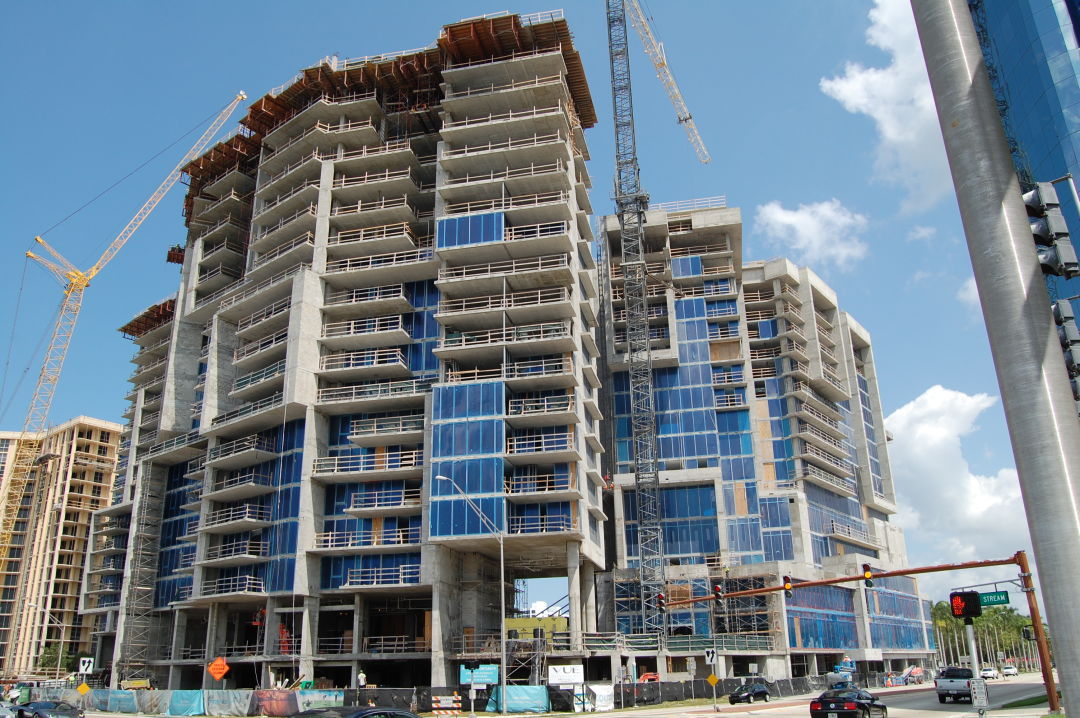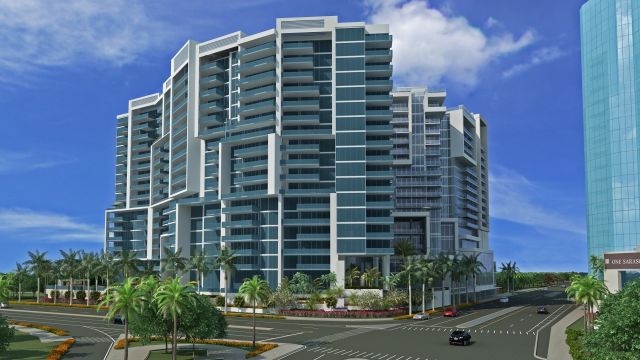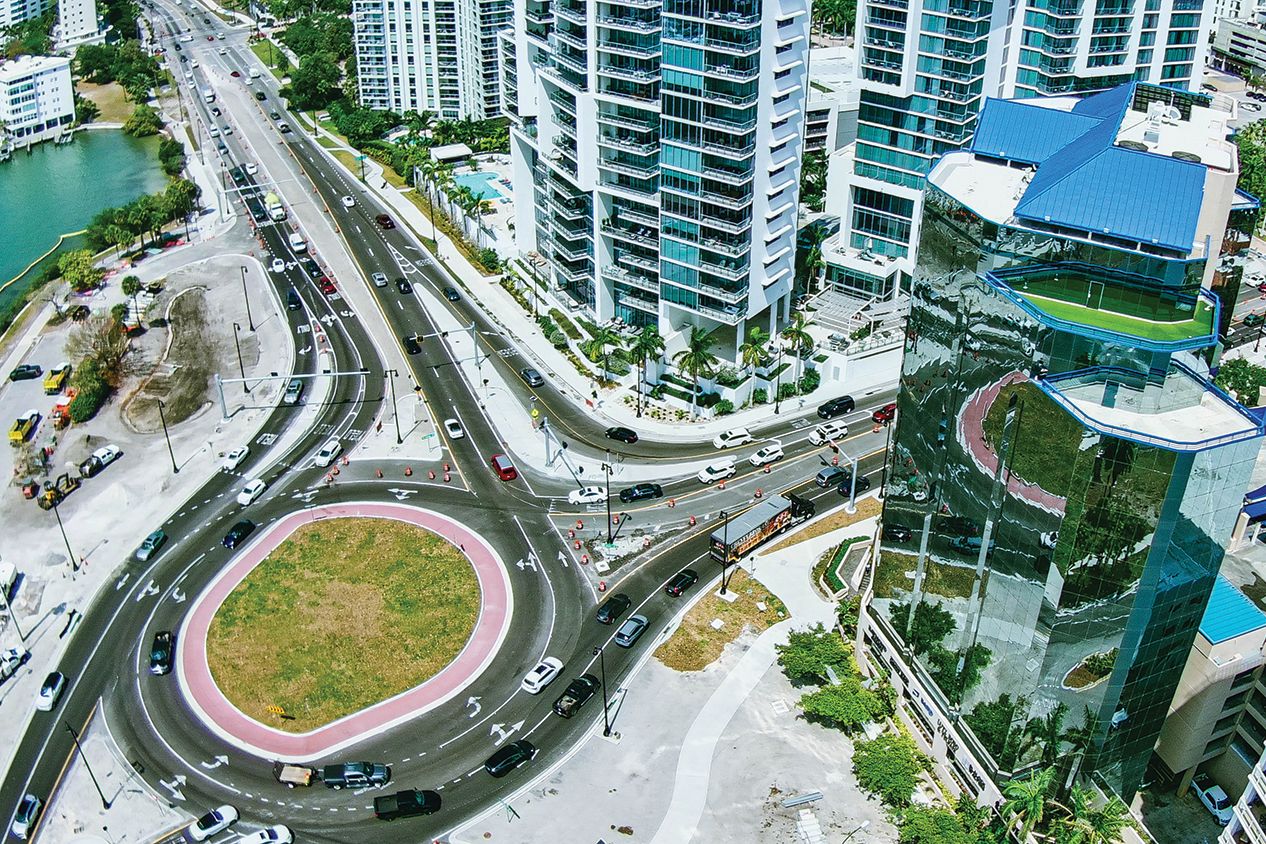How Did Sarasota's Massive New Vue Win Approval?

The grumbling began as soon as the $300 million Vue Sarasota Bay broke ground in September 2014. Some of the complaining can be chalked up to people’s discomfort with change—especially when that change is on a high-visibility, high-traffic vacant lot that had allowed glimpses of the sparkling bay and Ringling Bridge.
But as the construction continued, the concern heightened, until it seemed there was almost universal rage this spring when the huge skeleton of the Kolter Group’s two 18-story towers—a condo and a hotel set at a right angle to one another along U.S. 41 and Gulfstream Avenue—came right up to the sidewalk, obliterating the sky and looking as though it could topple over into the street. Letters to the editor in the Herald-Tribune demanded to know how such a monstrous structure could have ever won approval. “Oh, you mean the No View,” said one land use attorney when asked about the project.
But the Vue’s size and positioning were predictable, given our zoning code. For many years, the site was home to a Holiday Inn (later Inn by the Bay) and a Denny’s restaurant. In 2003, developer Richard Zipes purchased that parcel and, later, an adjacent site along Gulfstream Avenue for $28.7 million, giving him 2.9 acres of prime downtown property. Zipes eventually submitted plans to build the Metropolitan, an 18-story, 144-unit condominium, which was perfectly within the permissible 18-story height and zoning of 50 units per acre. Then in 2005, the Kolter Group bought the property and Zipes’ plans for $40 million.
The project lay dormant during the recession. In 2013, Kolter resurfaced with a project that consisted of a 141-unit condominium and a 255-room, 18-story hotel. A May 16, 2014 city document states that the project received “Administrative Approval.”
That’s right. Administrative approval. The city commission held no hearings about the project, nor did they vote to approve it. That’s how the process now works. Under the City of Sarasota’s zoning code, projects within the city core and bayfront are reviewed by city staff for compliance with the code and then approved by Tim Litchet, the head of the city’s Neighborhood & Development Services. This process is the result of a long public debate about creating a vibrant, pedestrian-friendly city that encourages people to live, work, shop and dine downtown.
New Urbanism guru Andres Duany was hired in 2000 to help create the Downtown Master Plan 2020, a set of standards intended to help downtown transition from gawky adolescent to sophisticated young adult. Developers had complained that the city’s approval process had been too onerous and capricious, giving them little incentive to invest in downtown, which at that time lacked many of the condos, restaurants and shops it has today. The new plan, adopted on Jan. 22, 2001, encouraged new building by creating clear standards that developers could count on. The standards also protected citizens by ensuring that developers couldn’t build whatever they wanted, says Mike Taylor, who was a Sarasota city planner from 1982 to 2012 and is now retired and living in Michigan. But the plan did not mandate administrative approval for all projects that met those standards; city commission hearings were still an option.
Some developers, city property owners, Argus and the Gulf Coast Builders Exchange were unhappy with aspects of the new master plan and challenged it in 2003. To avoid costly litigation, the city agreed to make administrative approval a formal part of the zoning code. Under the modified plan, as long as developers follow the rules, city staff can approve the project, and the city commission has no say in the matter.
(Administrative approval is not a new concept. Single-family homes and smaller commercial structures in the city were approved by staff sign-off before the 2020 plan, says Taylor. Larger structures, however, had to go before the planning board and then the city commission for approval.)
The Vue’s claustrophobic position along U.S. 41 complies with one of the city’s design standards, which stipulates that buildings on primary roads must come right up to the sidewalk. The intention is to make pedestrians feel connected to the building and to give them something interesting to look at, like storefronts and offices, as they walk along city streets, rather than facing a blank wall. But because it’s on U.S. 41—a highway more than a city street—few pedestrians will be walking next to the Vue, which in any case, has no retail or office on the ground floor. There will be windows looking into a fitness center.

A rendering of the Vue, minus the nearby traffic.
And that 255-room Westin Sarasota hotel on the property? Non-residential structures, like hotels, have no density restrictions. Kolter could have packed as many hotel rooms as it wanted on that parcel as long as it met the code, says Taylor.
Take one look at downtown today and it’s clear the master plan has succeeded in enabling new development. But it’s also made it difficult for citizens to stop projects. First, you have to register with the Office of City Auditor & Clerk to be notified about a specific project. But it’s a Kafkaesque predicament. How do you register to learn about a project that you have never heard of? (Alternatively, says Taylor, you can register to receive the staff’s monthly list of projects in the works; you can also attend their monthly project review meetings—although you’re not allowed to speak there.)
If you want to appeal, you must do it within 10 days after the project has received administrative approval. If you do learn about the project in time and decide you want to challenge the approval, you must spend $1,097 to file an appeal and put $500 more in escrow. The appeal goes to the city’s planning board. If the planning board upholds the administrative approval, the challenger again can appeal—for another $1,600—directly to the City Commission.
In the 15 years since the master plan has been in place, there has been only one appeal to overrule administrative approval. Earlier this year, the Laurel Park neighborhood appealed the approval of a new loading dock at the Woman’s Exchange. The neighborhood association won, but only after it filed a second appeal to go in front of the City Commission, which voted 3-2 to deny the dock.
Ritz-Carlton residents did challenge the Vue by hiring an attorney and commissioning a study that concluded the project would cause them traffic problems. That didn’t change anything. “We were told by the city that traffic considerations on Ritz-Carlton Drive could not be considered until after the building was built and the traffic was flowing,” says Eileen Normile, a Ritz condo owner and former city commissioner. But they never actually appealed the project’s administrative approval. “We were surprised by that,” admits one city staffer.
We’ll have more big buildings to get used to as other downtown condos, apartments and hotels rise after administrative sign-offs. Kolter recently announced another large downtown project. Called The Mark, it’s taking over another old project that never materialized, Isaac Group Holdings’ Pineapple Square. The Mark includes 157 units in 12 stories with 35,000 square feet of retail space and 11,000 square feet of office space on the ground floor. The rendering shows a structure that stretches almost an entire block just south of Main Street.
And despite concerns that the Vue will create gridlock at Gulfstream and 41, Kolter announced in April that it would be building an 18-story, 86-unit condo, called The Grande at the Ritz-Carlton Residences, Sarasota, near the Vue. It will be next to the existing Ritz-Carlton hotel.
Taylor notes that Sarasota is filled with projects that were hated at first. He recalls the outcry over the glass office building One Sarasota Tower across from the Vue, the condominiums 888 and 988, and The Ritz-Carlton, which took the place of the beloved John Ringling Towers.
“The Vue is something you’ll get used to,” Taylor predicts.
Others point out it may not feel like such a hulking monster when it’s completed and painted white with walls of windows. And a roundabout that’s scheduled to be constructed at U.S. 41 and Gulfstream in 2021 will create a wider buffer from traffic.
Meanwhile, administrative approval may be expanding beyond downtown. The city’s Urban Design Studio is three years into creating a new zoning code for the entire city called form-based zoning. The city has held meetings for citizen input, and the commission is expected to vote on the code this fall. If they approve it, it’s likely that administrative approval rather than commission hearings will be the norm for many projects throughout the city.



